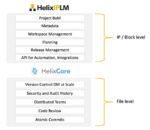The development of cost effective, high-performance silicon to silicon interconnect at the system level can be a vexing problem. So many choices, which one will work best? Ease of use and customer support are woven into the DNA of Samtec. Almost four years ago I explored the company’s focus on putting the customer first here. Fast-forward to today, the options are more plentiful, and the complexity has gone up. This is why a new approach from Samtec to make it easier to identify the best interconnect architecture caught my eye. Let’s explore how Samtec simplifies complex interconnect design with Solution Blocks.
Silicon-to-Silicon Solutions, Simplified
Thanks to the incredible rise in AI/ML applications, data centers are experiencing disruptive demands regarding compute performance and data throughput. These demands put extreme stress on both copper and optical channels. Finding the right mix of technologies to support these new AI-fueled demands is far from simple.
From standard cataloged products to unique high-performance design, Samtec’s Solution Blocks are designed to support any interconnectivity need, regardless of application, performance requirements or environment. Let’s examine the various Solution Blocks Samtec offers to organize and simplify high-performance channel design.
High-Speed Board-to-Board and Backplane
In this Solution Block, we explore high speed connectors, mezzanine systems with integral ground planes, high-density arrays, backplane interconnects, rugged signal integrity optimized Edge Rate® systems and high-speed performance to 56 Gbps NRZ/112 Gbps PAM4. Some of the options offered here include:
High-Speed Performance, with speeds to 112 Gbps PAM4. More than 4.0 Tbps of aggregate bandwidth and extremely low crosstalk beyond 40 GHz.
Application Flexibility that includes 10-1,000 positions with 1 mm – 40 mm stack heights and vertical, right-angle, edge mount configurations.
Signal Integrity Support with free test reports, models, app notes, and break out region. Easy access to live EE support and a unique Channelyzer® online tool.
There is a substantial pallet of connectors to get the job done. These include: High-Density Arrays, High-Speed Dual Row Strips (Mezzanine), High-Speed Edge Cards, Ultra Micro Interconnects, and Backplane Connectors. The figure below summarizes the bandwidth options that are available.
Optics Transceiver Solutions
When power and bandwidth demands become unmanageable for copper, optical interconnect becomes attractive. Samtec is the industry-leading provider of mid-board optical transceiver solutions. Reliable signal integrity over an extended distance in chip-to-chip, board-to-board, on-board and system-to-system connectivity is what attracts design teams.
Optical channel design can be quite challenging. Optical products include Samtec’s Sudden Service® – full engineering support, online tools and that strong service attitude I mentioned previously. Some of the attributes of this product line include:
Low power that delivers minimal power usage per module in a small footprint. This allows for high-density placement close to the IC for significant power savings in the overall system.
Small form factor is enabled thanks to the flexibility of copper and optical using the same micro connector. This allows for increased density, simplified PCB and reduced power dissipation.
High-performance versatility because the data connection is taken “off board” for up to 28 Gbps per lane with a path to 112 Gbps PAM4 via optical cable at greater distances.
Integrated thermal management with a variety of integral heat sinks or through-the-board cooling provides optimal thermal control for harsh environments and wide temperature ranges.
A complete range of optical cables and connectors are available, supported with evaluation boards and development kits.
High-Speed Cable Interconnect Solutions
When copper is the choice, Samtec’s high-speed cable systems – Flyover® and HDR – provide innovation for next generation architectures with industry leading support, in-house manufacturing and customization capabilities to create a solution for any application.
There is wide selection of cable interconnects available in this Solution Block. Some of the key attributes include:
Flyover® Architecture that improves signal integrity & reach at higher data rates. In-house high-level design & engineering support is available to ensure a successful design supported by full system signal integrity expertise.
Flexibility & Customization facilitated by mix & match connector end options, extensive customization capabilities, and modular backplane flexibility.
Manufacturing is done by Samtec, with R&D/manufacturing of precision extruded cable & next gen RF cable in several global locations. The company offers multiple proprietary ultra-high performance cable technologies.
With this extensive product line, you can configure an optimal solution across many requirements. Solution Blocks helps to sort out the details for you.
RF Interconnect Solutions
Most systems will require some level of RF communication. Samtec offers complete RF interconnect solutions supporting traditional sub-6 GHz frequencies to 110 GHz microwave/mmWave frequencies (sub-Terahertz spectrum). Products include end-to-end RF cable assemblies, board connectors, cable connectors, adaptors and Samtec Original RF Solutions.
Samtec offers a wide range of RF cables and connectors to address just about any requirement. Some attributes of this product line include:
Cables included are phase & amplitude stable cables, microwave assemblies to 110 GHz, and RG cable solutions (RG316, RG174, RG178, etc.).
Connectors, including compression mount for test & measurement applications, board-to-board & cable-to-board, and precision in-series & between-series adaptors.
Taking Solutions Blocks for a Test Drive
Beyond presenting all the relevant product information in one place, Solution Blocks provide interactive, guided product selection to get your best choice fast. Links are coming so you can try it out for yourself. Here is a real session I did with the system:
Under the High-Speed Board-to-Board Solution Block, I pressed Explore Picture Search. That took me to a Solutionator screen. I then began making selections.
I chose an Edge Card connector type. This dynamically changed the balance of choices to be consistent with an edge card. Next, I chose a Vertical orientation with a .8mm pitch. I then chose 20 and 32 as valid position choices and a .062” card thickness. I was then presented with 9 results that fit my criteria. The system informed me I could click on any row for items like 3D models and free samples.
Below is a screen shot of the results. Assembling this list of valid options took seconds. Without Solution Blocks it would entail a lot of research.
To Learn More
Samtec’s Solutions Blocks can save you a lot of time on your next system design. I highly recommend you check it out. You can access the capability here. Don’t forget to try the Explore Picture Search functions. It’s a lot of fun to see what is compatible with what. And that’s how Samtec simplifies complex interconnect design with Solution Blocks.








